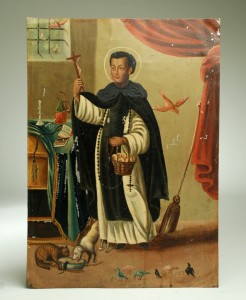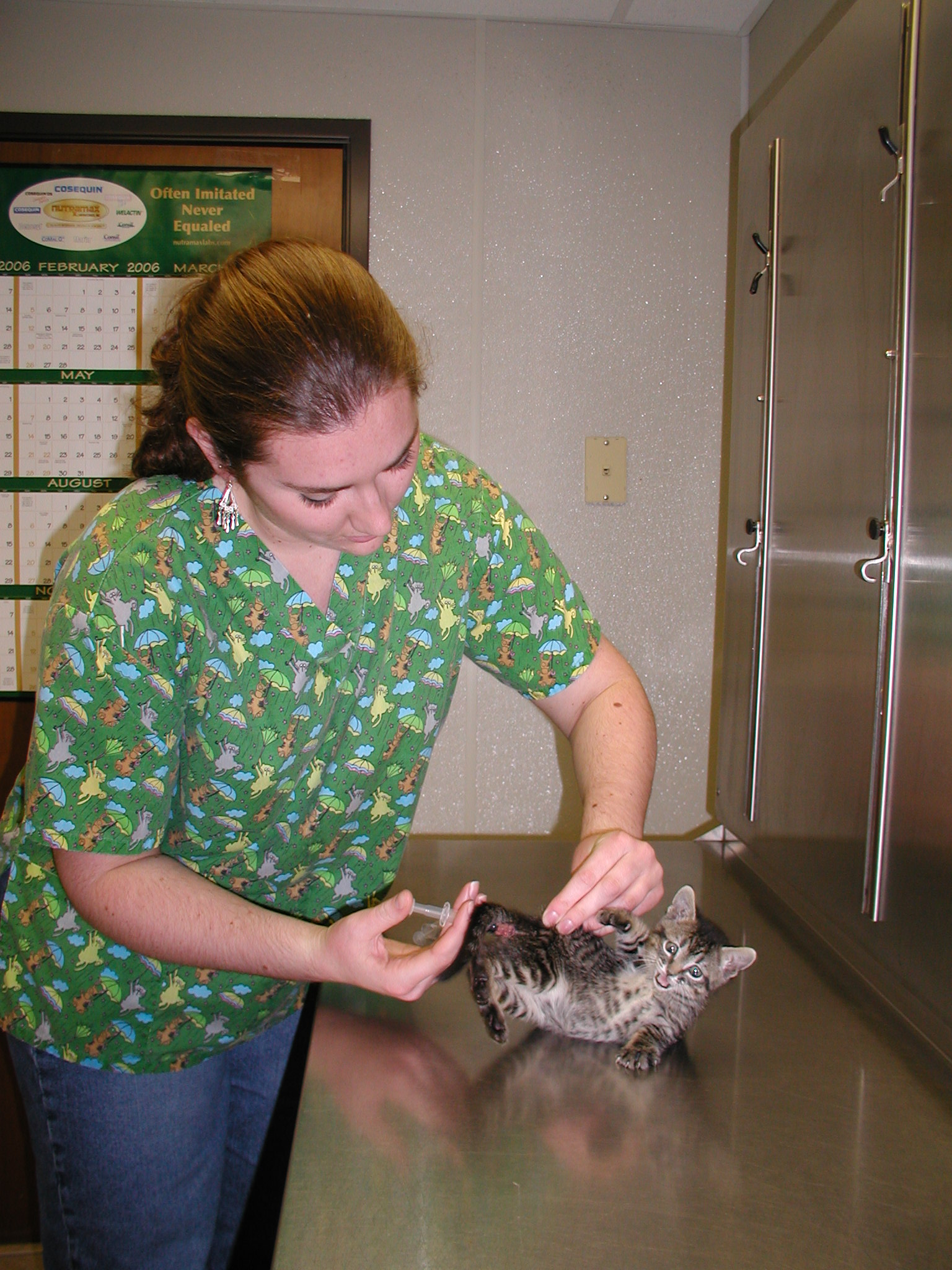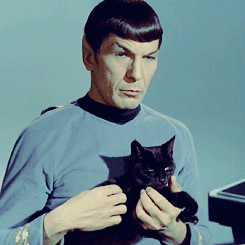St. Martin de Porres
 Patron Saint of Veterinarians, Rescuers, People of Color, Television, Hair Dressers & Trekkies
Patron Saint of Veterinarians, Rescuers, People of Color, Television, Hair Dressers & Trekkies
What do veterinarians, people of color, Trekkies and hairdressers have in common? In times of need they can all call upon St. Martin de Porres. He is one of the coolest saints around. The Dominican brother is recognized as the first black saint from the Americas.
Officially, he’s the patron saint of barbers, hair stylists, innkeepers, Mexico, black people, people of mixed race, Peru, poor people, public education, public health, and television (yes, the boob tube). He stands for interracial and social justice and racial harmony. (Certainly use his intercession with today’s racial strife.) People also invoke his name for protection from rats. Unofficially he represents veterinarians, Trekkies, holistic healers and people who are bullied.
Juan Martin de Porres was born 435 years ago today, on Dec. 9, 1579, in Lima, Peru. He was the illegitimate son of a woman of color (a freed Panamanian slave) named Ana Velázquez and the Spanish knight, Don Juan de Porres. Papa never married his baby mamma, and wasn’t proud that little Martin inherited his mother’s dark complexion. The “nobleman” abandoned his family three years later, after the birth of their daughter, Juana. What a guy! After Dad disappeared, poor Ana struggled to feed her kids by taking in laundry. Eventually Don Juan stepped up and sent his son to a primary school for a couple of years, after which 12-year-old Martin apprenticed as a barber.
As a trainee, he learned more than how to coif a mullet and sculpt a soul patch. In those days, barbers’ finely honed blades also opened veins for cozy sessions of bloodletting. Martin learned to perform surgeries, dig out ingrown toenails, lance boils, set bones, dress wounds, treat disease and compound medicine from herbs. The training gave him the ability to care for the sick and destitute without charging a fee.
 Just like Mr. Spock, St. Martin de Porres was able to be several places at once.
Just like Mr. Spock, St. Martin de Porres was able to be several places at once.
When he turned 15, Martin entered the Holy Rosary Dominican Priory in his hometown. At that time, Peruvian law prohibited descendants of Africans and Indians from becoming full members of religious orders. So Martin wore the monastery’s habit and performed worked in the infirmary as a barber-surgeon as well working on the farm and performing menial tasks in the kitchen and laundry.
In and outside the convent, Martin became known for his miraculous cures; he treated noblemen and slaves alike without regard for their race or social status.
When he turned 24, Martin took charge of the friary’s infirmary, where he worked until he died. He opened a children’s hospital for kids living in the slums and the Orphanage of the Holy Cross. Eventually the Dominicans ignored the racial restriction and allowed Martin to take vows as a Dominican brother.
A Real Dr. Doolittle
 St. Martin’s compassion wasn’t restricted to humans. He was a 16th-century Dr. Doolittle, with the ability to communicate with animals. Like St. Francis, Martin treated animals as if they were brothers and sisters. Only a Hannibal Lecter would chow down on his family, so Martin never ate meat. Centuries ahead of his time, the barber-turned-veterinarian treated sick and injured cats and dogs at his animal hospital set up at his sister’s home in the country. He also founded a shelter for stray pets.
St. Martin’s compassion wasn’t restricted to humans. He was a 16th-century Dr. Doolittle, with the ability to communicate with animals. Like St. Francis, Martin treated animals as if they were brothers and sisters. Only a Hannibal Lecter would chow down on his family, so Martin never ate meat. Centuries ahead of his time, the barber-turned-veterinarian treated sick and injured cats and dogs at his animal hospital set up at his sister’s home in the country. He also founded a shelter for stray pets.
While officially St. James the Greater, St. Eligius and St. Blaise are the patron saints of veterinarians, people with sick kitties and poopy pooches might want to have a conversation with Martin de Porres. After all, this guy was a practicing vet.
Of mice and Martin
Even potentially plague-carrying vermin benefited from St. Martin’s mercy. A mischief of mice set up housekeeping in the priory’s linen wardrobe. (And we know, nothing conveys the concept of “holy” like altar linens covered in mouse poop.) The monks wanted to poison the furry invaders, but St. Martin had other plans. Reminiscent of St. Francis’ negotiations with the killer wolf of Gubio, Martin simply promised not to promote the mice to Glory if they would relocate to a little den at the end of the garden. Martin even offered to cater their meals. Then, in a Peruvian version of the Pied Piper, he led Mickey’s cousins to their new digs. The mice stayed away from the linens, and Martin kept his part of the bargain.
Beam me up, Marty
 Martin is the official patron saint of television and (appointed by me) unofficial saint of Trekkies. Stick with me on this.
Martin is the official patron saint of television and (appointed by me) unofficial saint of Trekkies. Stick with me on this.
While Martin wanted to serve as a missionary, this was not to be. But stories persisted describing Martin visiting those in need through bi-location (meaning he could safely fold clothes in the laundry in Peru while treating a patient in Algeria).
Five centuries before Chief Engineer Montgomery Scott was a gleam in Gene Roddenberry’s eye, Martin managed to transport himself around the globe. The word “television” means “vision from afar” in Greek. A man who bi-locates certainly represents that concept.
You might wonder if being in two places at the same time has something to do with those herbs he learned to compound in barber school. Probably not. The claims of his visitations came from the people he helped. Even though Martin never left Lima, people said the saint appeared to them in Algeria, China, France, Japan, Mexico and the Philippines.
Locked doors couldn’t keep Martin from caring for the sick. During an epidemic, sixty novice friars living in a locked section of the convent fell ill. Several of them reported seeing Martin pass through locked doors like Captain Kirk in the “Tholian Web.” These claims were even verified by monastery superiors.
In icons, St. Martin is usually depicted along with a cat, dog, and a mouse eating from the same bowl. He’s also associated with a broom (because of his love of manual labor), a crucifix, a rosary and/or a heart.
Nov. 3, 1639, Martin teleported from his corporeal body for the final time. He died of quatrain fever at his beloved Rosary Convent at the age of 59. The man who was rejected by society, and even his own father, was carried to his resting place by church prelates and noblemen. He was canonized by Pope John XXIII in 1962.
So next time you go to the vet, feel bullied, or watch a rerun of Star Trek, you might have a conversation with St. Martin de Porres. After all, he communicated with animals and bilocated to exotic places. He’s not likely to let a little thing like a grave come between him and someone in need.
If you want to learn more about this amazing man, visit Saint Martin de Porres – Patron of Social Justice.












Recent Comments